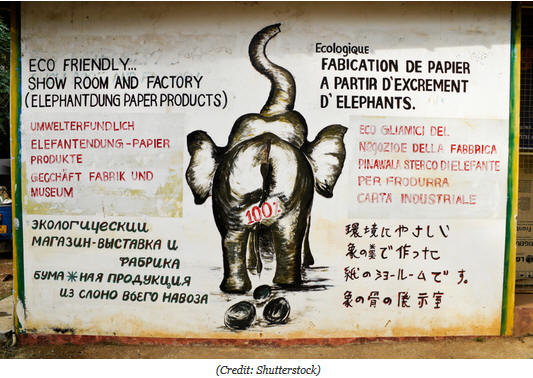 |
| Reviews and Templates for Expression We |
Sustainable Paper, Brought to You by Elephant Dung

Scientists may have found a way to generate environmentally friendly paper from poop—cow and elephant poop that is. Although this may seem strange and unconventional, this poo-per actually offers a more simple and sustainable alternative to the traditional, resource-intense papermaking process.
The cows and elephants streamline the papermaking operation by taking up a good chunk of the pre-processing duty in their digestive system.
In traditional paper production, non-wood pulp and wood pulp tend to undergo various chemical and mechanical processes to produce paper. There have been a lot of positive changes with improving and recovering recycled materials. However, it’s still not as efficient and environmentally sustainable as hoped. Enter manure.
Andrew Bismarck, a PhD at the University of Vienna, Austria noticed that goat manure was comprised of partially digested plant matter, which he hypothesized must contain cellulose.
Cellulose is an important component of paper. Typically, a lot of processing has to be undergone to retrieve usable cellulose from pulp.
He and his team noted that roaming herbivores’—such as the elephant—diets consist of high-fiber, cellulose containing materials, of which they digest only 30 to 40 percent. The size of the animal is positively correlated with the amount of usable material they can produce. From ingestion to excretion, the animal typically chews up the material and passes it through the stomach where it’s broken down with acid and enzymes, bypassing many of the energy-intensive chemical treatments that raw wood requires to create the same product.
The manure requires little post-treatment to remove impurities and preparation for use in paper. By reducing the amount of steps, the sustainable product saves a tremendous amount of energy and chemical use. The resulting paper is also sturdier than conventional paper such as newspapers ans can be produced with consistency, Bismarck and colleagues say. In addition to being used to write on, the paper made from these living processing plants can also be used as filters, reinforcement and polymer composites. Bismarck mentioned that it could also be a good replacement for coffee filters (potentially a good accompaniment to poop coffee?).
In places with a bountiful supply of dung, namely elephant parks in Africa and cattle farms, raw material could flow in by the truckload daily. Utilizing this method to upcycle the manure can help both save trees and manage waste. Bismarck and his team are currently working on making the process even more sustainable by attempting to make use of all the byproducts of the treatment and extraction. You know what they say: waste not, want not. Their methods and findings were published last week by American Chemical Society.
Although this is a lofty discovery, they’re not poop paper innovators. Late last year, scientists from China used panda poo to make facial tissues. The elephant and cow poo paper are the newest addition to the poo paper family. You can even purchase them at the online store.
|
|
|
|
Copyright remains with the original authors |